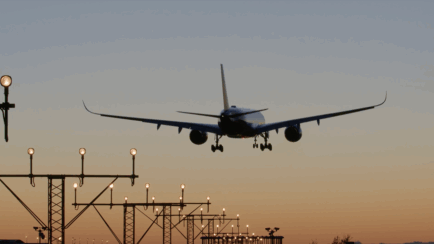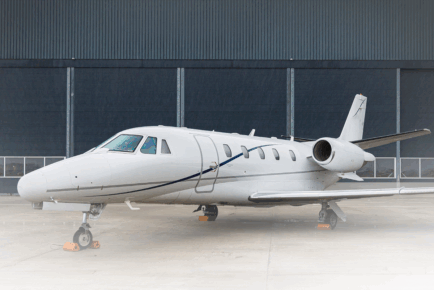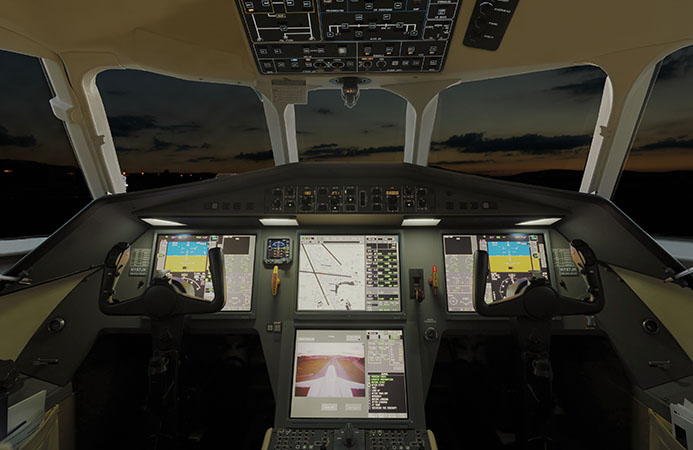
AvBuyer Magazine, December 2015
by Ken Elliott
Helping you understand avionics advances and related requirements for equipage, Ken Elliott reviews aviation technologies within the NextGen/SESAR architecture, and this month provides an overview and conclusion to his series.
As we enter the final month of 2015, reflection on the current status and future of NextGen implementation may be helpful.
Throughout 2015 Original Equipment Manufacturers (OEMs) and Maintenance Repair Organizations (MROs) have been busy developing and completing their aircraft solutions for Automatic Dependent Surveillance–Broadcast Out (ADS-B Out), as well as Future Air Navigation Systems (FANS). Equipment suppliers have been introducing new and improved technology, while the FAA has readied itself for ADS-B Out, made strides with Data Communication (Data Comm) and introduced more Performance Based Navigation (PBN) procedures.
As aircraft OEMs provide NextGen hardware and software updates (available via their dedicated customer portals), MROs have been announcing creative installation choices for legacy aircraft. It is common to find one-time equipage upgrades, embracing both FANS and ADS-B needs.
All providers claim their offering to be the most cost-effective. There are several competing solutions on the same platform, such as the Bombardier Challenger 604. However, as aircraft age their equipage changes; so be careful to select a system that effectively integrates with your current avionics.
Across the world, implementations vary by date and by class of aircraft, operations and airspace. This makes for a complex unraveling of compliance requirements, especially for those who operate throughout different regions of airspace.
Dates and other variables are partially covered in this article, and some operators understandably believe these dates will inevitably shift to the right. However, with ADS-B Out there is little sign that slippage will happen. There has been some give in the GPS requirements of ADS-B, largely as a concession to the airline lobbyists, but there are a number of stringent conditions attached. The FAA, at least, will likely remain firm on its January 1, 2020 ADS-B Out deadline for equipage.
From a general perspective, currently the world can be divided into three groups of future aviation improvements:
• FAA NextGen;
• EU Single European Sky ATM Research (SESAR); and
• ICAO Global ATM Concept – Block Upgrade Plan.
While other nations have noteworthy programs, such as Australia’s OneSKY, Japan’s CARATS and China’s ATMB collaboration with Airbus, they are all linked in one way or another, with one or more of the three major programs listed above.
Data Comm
The FAA is on target to implement Data Comm at over 50 ATC Towers and Tracons in 2016 and En-route Centers before 2020. Successful trials were completed at Newark Liberty International Airport (EWR) and Memphis International Airport (MEM), allowing recent expansion to Salt Lake City International Airport (SLC) and William P Hobby Airport (HOU). In Europe, VDL Mode 2 is being phased in over the next several years as the ground facility updates that were behind schedule, are completed.
FANS and Oceanic Tracks
The North Atlantic datalink mandate began with Phase 2a in February 2015, with FANS 1/A controller-pilot datalink communications (CPDLC), and ADS-C, required between FL350 and FL390. This requirement expands to the entire ICAO NAT region on December 7, 2017, and in January 2020 it applies to flights in this region above FL290.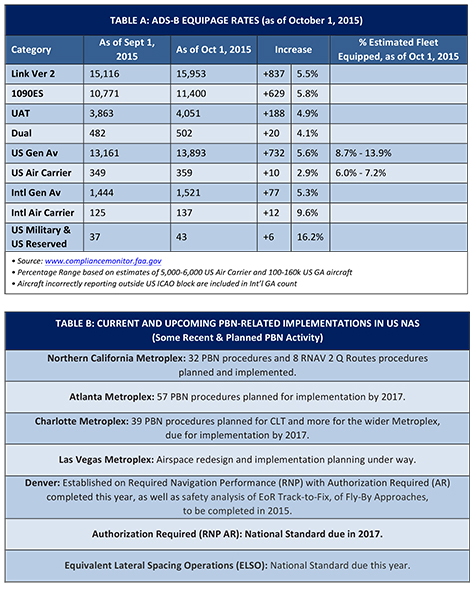
ADS-B Out
All FAA 634 ADS-B ground stations have been completed, and there are over 50 solutions either approved, or in work and listed on the FAA ADS-B website.
Table A (sourced from FAA), provides a good overview of ADS-B aircraft equipage status. From October 1, there were 51 months remaining to equip 91.3% of the US-based GA fleet, being mindful that proportionately, the light GA sector comprises a much bigger number than corporate aircraft.
The international mandate for ADS-B varies by country or region and by new or in-service aircraft types:
• For the US, it is January 2020;
• In Europe, new aircraft (June 2016) and in-service (June 2020);
• Other regions have either already implemented versions of ADS-B or have plans to do so.
PBN
Precision Based Navigation procedures dependent on satellites are migrating more and more across the US airspace (Table B). Recently we have seen Metroplex procedures at Houston, Washington DC, and Northern California. For corporate aircraft, the intended expansion into Las Vegas Metroplex that may commence in 2016 could be of particular interest.
FAA has a 2018 goal of 10% efficiency improvement at core airports, using flight paths unconstrained by conventional Navaids and using, point-to-point, GPS procedures.
PBN includes precision approaches using Wide Area Augmentation System (WAAS), popular with General Aviation. There are 1,739 airports served by 3,567 WAAS approaches and a whopping 995 of these do not have traditional Instrument Landing Systems (ILS) at the runway itself.
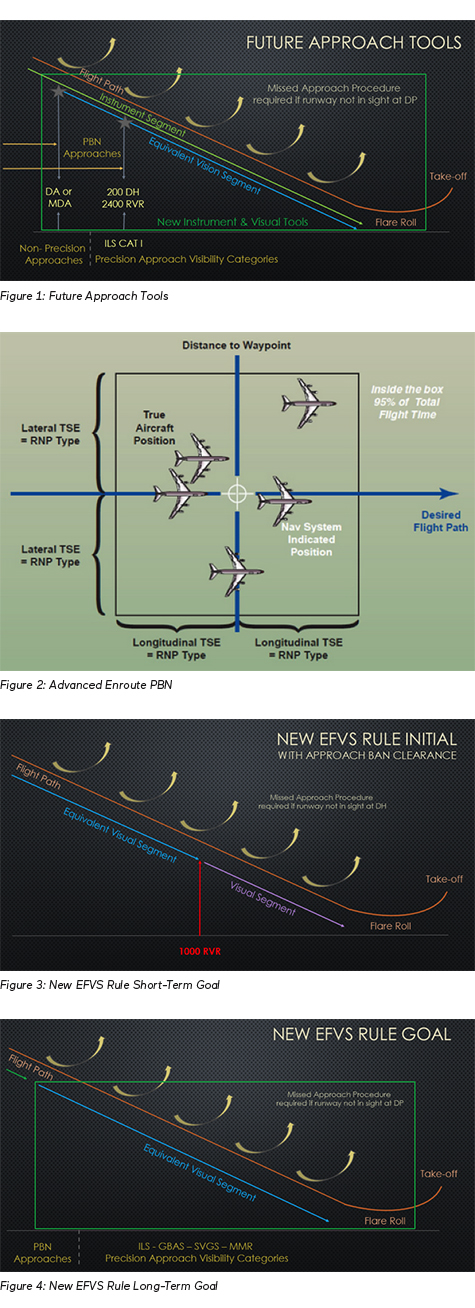 Enhanced Low Vision Operations (ELVO)
Enhanced Low Vision Operations (ELVO)
The FAA has yet to release the new ground-breaking rule, allowing all Enhanced Flight Vision System (EFVS) operators, irrespective of operating category, to dispatch, begin and complete approaches during low visibility conditions. The new CFR 91.176 rule is still due for distribution in 2015.
The FAA and Radio Technical Commission for Aeronautics (RTCA) are preparing a new operation advisory for the use of Synthetic Vision Guidance during low visibility. Separately, GPS Based Augmentation System (GBAS) approaches are still being considered for major hub runways.
As PBN procedures develop, the enhancing of these with ELVO becomes more apparent. Meanwhile, equipment developers are fast creating new technologies that will enable operators to meet the full intent of the rule.
Figure 1, ‘Future Approach Tools’ shows ways to fly the final approach segment that may be introduced over the long-term. There are no upcoming mandates for ELVO, but the FAA, EUROCONTROL and ICAO continue to aggressively plan for implementation via enabling guidance.
TCAS 7.1
In its early form, TCAS 7.0 had some resolution advisory issues. As a result, the European Commission Implementing Rule 1332/2011 now mandates the carriage of ACAS II version 7.1 within European Union airspace from 1 December 2015, by all aircraft currently equipped with version 7.0.
Since upgrading to 7.1, some aircraft have had different resolution advisory issues that are not from ahead of the aircraft, but spuriously occur from behind, originating from other aircraft activity. These are addressed in FAA InFO 15005, published March 2015.
NextGen to 2020
The FAA has a Systems Engineering plan (SE2020) for near- to mid-term NextGen implementation. This will be followed by SE2025, taking the US to another level of a fully integrated national airspace. Europe’s SESAR shows its public implementation calendar out to 2021.
Presently, the FAA has a core focus on ADS-B that, with its ground stations in place, is more concentrated on fleet equipage and operator preparedness, in time for the 2020 ADS-B Out mandate deadline. The FAA has four other core focus areas in its plan, including:
• Data Comm;
• PBN;
• Multiple Runway Operations (MRO); and
• Surface.
In addition, the FAA is concentrating on Time-Based Flow Management (TBFM), En-Route Automation Modernization (ERAM) and System Wide Information Management (SWIM). These three areas provide the infrastructure to support the four core focus areas.
2020-2025 & Beyond, By Technology
Regarding the period 2020-2025 (SE2025) and indeed beyond, there are some interesting developments in government and industry collaborative planning.
Very obvious and significant is how all the technologies that follow are interrelated. As one program implementation progresses, it enhances others. Beyond 2020, operators may experience exponential benefits from their NextGen investments. The public, as flyers and taxpayers, certainly should reap time and predictability benefits one can only wish for today.
ADS-B In
The next big enhancement of ADS-B is the ‘In’ phase, where aircraft may view other aircraft activity, in relation to their own, on cockpit displays. With ADS-B In, everyone on the ground, and in the air, may have the situational advantage of knowing where everyone else is, within a prescribed distance of themselves.
Surprisingly few realize the wider benefits of ADS-B surveillance. Here are a few of those:
• In-flight automated weather, notices and other useful info;
• Flight interval management and closely-spaced parallel operations;
• In-trail procedures when in Oceanic Airspace (via ADS-C);
• A critical tool in the time-based operations (TBO) toolbox.
Data Comm ATN B2
The FAA, industry and RTCA are closing in on final recommendations for the Air Traffic Network (ATN) version B2. ATN B2 takes FANS over VDL Mode 2 to a different level. It allows for:
• Dynamic RNP;
• Advanced flight interval management including winds;
• 4D trajectory operations;
• Deletion of jet routes in favor of Q and T routes; and
• Positive impacts to SIDs and STARs.
The means of communication, meanwhile, may increase from satellite and VHF to L band, providing many options for continent-wide Data Comm.
Advanced PBN
Interestingly, the FAA and industry are working together with RTCA (via an Ad Hoc Work Group) on a new PBN strategy that considers all the current concerns of PBN implementation, the stakeholder interests and a focus on a fully coordinated long-term strategy.
As PBN migrates across Metroplexs, there are concerns for the future, centered on both unintentional and deliberate GPS interference. Instances have occurred, and tests show that there are vulnerabilities. These may increase as cyber security becomes a bigger issue for all.
Wisely, FAA policymakers are reconsidering the draw-down of conventional Navaids, primarily with respect to DME coverage. In fact by broadening the current DME-DME coverage and creating a new hybrid technology incorporating ADS-B, the FAA may have a steadfast Plan B solution to the GPS problem (particularly vulnerability to jamming).
New ‘advanced technology DME ground stations’ would continue to provide a high degree of alternative position accuracy into existing cockpits. The ADS-B information will complement the DME signals and create Alternative Positioning, Navigation & Timing (APNT).
Meanwhile it is a goal of FAA to see, by 2030, all aircraft equipped with some form of PBN Lateral Path Vertical (LPV) navigation. However, certain air carriers have expressed concern over the difference in LPV implementation across the globe, making them reluctant to equip for international operations.
Advanced PBN promises to bring continuous descents, ascents, Q routes, IFR trajectory-based flights, vector free arrivals and EoR final approaches, on parallel runways.
ELVO
Enhanced Low Vision Operations using several different technologies and means of guidance may eventually change IFR to VFR everywhere during approaches to touchdown and roll-out. Some technologies GBAS (as GAST-D), SVGS and Multi- Mode Receivers (MMR) may extend the instrument segment of the approach nearer to the touchdown zone (TDZE) of the runway.
Enhanced Flight Vision System (EFVS) introduces an equivalent visual segment, extended to the TDZE by reliable and predictable vision systems, currently in development. Advances in EFVS are promising much lower equipage costs as well as space and weight saving head-worn displays, or cameras that will bust through the most extreme of low visibility, including cloud, fog, rain, snow, haze, dust and smog.
New FAA and later global rules will enable these profound changes to operations once the technologies are fully mature.
Surface
Currently the FAA has eight surface visual tools (SVT) under evaluation by controllers. TRACON’s and ARTCC’s will be able to monitor real-time surface traffic as if in airport control towers. Aircraft Electronic Flight Strips (AEFS) will be introduced at Newark Int’l in 2016, allowing automated airfield guidance and adding to SWIM surface surveillance.
When ADS-B In is widely embraced and implemented, huge on-ground benefits will be realized. Increasingly, under the FAA Surface Movement Guidance Control Program (SMGCS), airports are becoming safer with improved markings, lighting, safety-related guidance and much more.
Unmanned Aircraft Systems (UAS)
Think of UAS as Medium- or High-Altitude platforms. The current concerns, centered on Low Altitude or small UAS (sUAS) operations, are both valid and influential in the long-term certification process for operating unmanned devices anywhere.
However, industry is only just defining the proper equipage for Communication, Navigation & Surveillance (CNS) for the unmanned aircraft that are intended for operation in the airspace shared by manned aircraft. RTCA recently released preliminary documentation on the UAS CNS and other aspects of this issue.
UAS platforms intended for shared airspace will be highly sophisticated, safe and more like manned aircraft. Importantly, they will undergo the same rigorous, time-consuming certification process as manned aircraft. Recently, the first UAS was approved for operations in shared airspace, albeit with many limitations imposed.
From a NextGen perspective, UAS will be treated just like manned aircraft, but expect a slow and delayed migration into manned airspace. It may take a lot longer than many believe before we truly see large numbers of UAS operating into our major airports.
4D Trajectory Operations
The FAA Air Traffic Organization (ATO) has a very interesting concept and long-term vision for the US airspace. This involves metering by time and speed rather than by distance. So, in some cases, an aircraft may fly slightly further, but will arrive ontime and correctly spaced, at a specific point in space. This enables predictability in Time-Based Flow Management (TBFM), and owning predictability is an ace card for Air Traffic Control.
A wide range of strategies and technologies feed into this concept, including SWIM, MRO, Advanced PBN, ATN B2, ELVO, ADS-B, Surface improvements and much more.
Some of the trajectory operation programs cover predicted time at waypoints during cruise, point in space metering for better separation, integrated departure and arrival concept (IDAC), and a reduction of the need for circling and holding flight patterns.
Summary
The ICAO Global ATM Concept block program is the cornerstone of the next generation of airspace. The US FAA has run with the ball and created a well-orchestrated implementation of its own NextGen SE2020 program. Eurocontrol’s SESAR while very impressive, is subject to local interpretations and some delays. Other international programs show excellent initiatives, perhaps best shown by Australia’s ADS-B program, already partially in place.
When you hear NextGen terms, such as ADS-B, FANS (Data Comm), PBN and ELVO, it can be quite confusing, but do not be deterred. All of these implementations are closely related and will exponentially enhance one another.
Equipping for each may seem painful, but the benefits outweigh the investments, especially when equipage is fully embraced and the majority of operators share similar capabilities. As SE2020 moves into SE2025, benefits will become ever more apparent and flying will be a much better experience for all!
Useful Reference Sources:
• FAA NextGen including Performance Snapshots
• Skybrary Aviation Safety
• EUROCONTROL
• SESAR Single European Sky ATM
• ICAO Global ATM Concept
• FAA CFR 91.176 NPRM
• RTCA Incorporated
• AEA – Aircraft Electronics Association
• NBAA – National Business Aviation Association
Are you looking for more articles on avionics? Visit www.avbuyer.com/articles/category/business-aviation-avionics/
❯ Ken Elliott is a highly-respected industry authority on avionics as a member of the NextGen Advisory Council sub-committee and Technical Director, Avionics at Jetcraft. Contact Ken via [email protected] or www.www.jetcraft.com.
This article was written by Ken Elliott, Jetcraft Avionics – Technical Director, for AvBuyer Magazine. It was published in the December 2015 issue. Click here to view the Digital issue of the December AvBuyer or to view Archived editions.
SIGN UP FOR OUR MONTHLY JETSTREAM RECAP
Don't miss future Jetstream articles. Sign up for our Jetcraft News mailing list to receive a monthly eblast with links to our latest articles. Click to join the 1,800+ subscribers on our mailing list.
